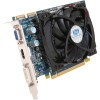- Qualcomm Launches Snapdragon 4 Gen 2 Mobile Platform
- AMD Launches Ryzen PRO 7000 Series Mobile & Desktop Platform
- Intel Launches Sleek Single-Slot Arc Pro A60 Workstation Graphics Card
- NVIDIA Announces Latest Ada Lovelace Additions: GeForce RTX 4060 Ti & RTX 4060
- Maxon Redshift With AMD Radeon GPU Rendering Support Now Available
Sapphire Radeon HD 4670 GDDR4 & HD 4830

Gaming on a budget isn’t as difficult as it once was, thanks to superb offerings from both ATI and NVIDIA that go for a modest price. But, what about the sub-$100 crowd? We’ll find that out here, at least from the ATI side of things, with Sapphire’s HD 4670 GDDR4 and HD 4830. Both feature great efficiency, and believe it or not, great overclocking as well.
Page 9 – Futuremark 3DMark Vantage
Although we generally shun automated gaming benchmarks, we do like to run at least one to see how our GPUs scale when used in a ‘timedemo’-type scenario. Futuremark’s 3DMark Vantage is without question the best such test on the market, and it’s a joy to use, and watch. The folks at Futuremark are experts in what they do, and they really know how to push that hardware of yours to its limit.
The company first started out as MadOnion and released a GPU-benchmarking tool called XLR8R, which was soon replaced with 3DMark 99. Since that time, we’ve seen seven different versions of the software, including two major updates (3DMark 99 Max, 3DMark 2001 SE). With each new release, the graphics get better, the capabilities get better and the sudden hit of ambition to get down and dirty with overclocking comes at you fast.
Similar to a real game, 3DMark Vantage offers many configuration options, although many (including us) prefer to stick to the profiles which include Performance, High and Extreme. Depending on which one you choose, the graphic options are tweaked accordingly, as well as the resolution. As you’d expect, the better the profile, the more intensive the test.
Performance is the stock mode that most use when benchmarking, but it only uses a resolution of 1280×1024, which isn’t representative of today’s gamers. Extreme is more appropriate, as it runs at 1920×1200 and does well to push any single or multi-GPU configuration currently on the market – and will do so for some time to come.




There’s nothing too unexpected here, with the two new cards on our test bench sitting in dead-last. Ultra-high resolutions like 2560×1600 proved a little complicated for the HD 4670 with this test. I had to run the Extreme test twice before it would complete, and when the resolution was changed to 2560×1600, it crashed the computer. Poor card… it’s gone through so much in the process of writing this review.
Support our efforts! With ad revenue at an all-time low for written websites, we're relying more than ever on reader support to help us continue putting so much effort into this type of content. You can support us by becoming a Patron, or by using our Amazon shopping affiliate links listed through our articles. Thanks for your support!






